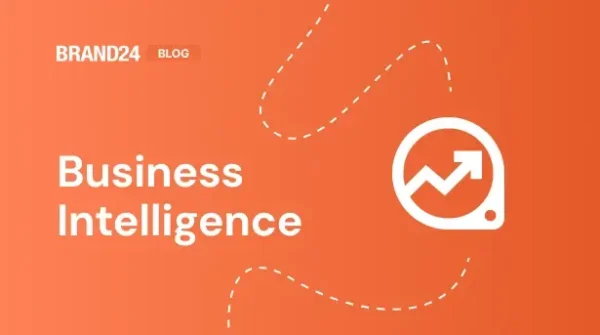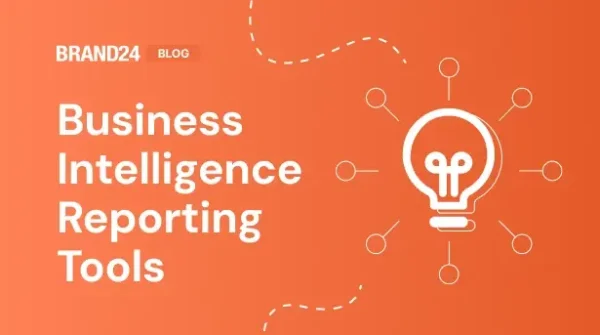The Ultimate 2025 Guide to Brand Mentions for SEO & AI Visibility
Table of contents
Did you know that Google can rank your site higher? Even if there’s no backlink involved.
Brand mentions are becoming more and more powerful signals in traditional and AI search. A recent study by Ahrefs found that brands in the top 25% for online mentions appear in AI reviews over 10x more often than those with fewer references.
In this article, we’ll explore how to find brand mentions, make the most of them, and how their role is evolving in 2025.
But first, let’s rewind a bit:
- What’s a Brand Mentions?
Any reference to your brand name, product, or website (with or without a hyperlink). - What are Brand Mentions for SEO?
Brand mentions are direct signals for search engines about your brand. They boost semantic relevance, supporting E-E-A-T, increasing AI search visibility, and driving brand awareness. - How to monitor Brand Mentions?
To uncover all the benefits of a brand, it mentions its use of advanced media monitoring tools. Brand24 is designed to find online mentions across all social media platforms, forums, blogs, podcasts, and reviews.
Shall we?
What Are Brand Mentions (and Why Do They Matter for SEO)?
Basically, a brand mention is any reference to your brand name, but not only! There are also your branded products and slogan. Any related terms that can be associated with your brand.
They can be divided into two categories: by format and by intent.
| Category | Type | Description |
By Format | Tagged Mentions | Your brand is tagged or linked (e.g., @brandname on social media, or a hyperlink on a website (sometimes nofollow links)). |
| Untagged Mentions | Your brand is mentioned in plain text without a clickable link or tag. (Also called implied or default links). | |
By Intent | Direct Mentions | Your own brand name is explicitly used (e.g., “Nike”). |
| Indirect Mentions | Your brand is referenced through products, slogans, or campaigns (e.g., “Just Do It” without saying “Nike”). |
That’s why, to track key mentions, I like to start by making a list of all related terms. For example, instead of directly mentioning “Apple,” users can use AirPods, iPhone, iOS, or MacBook. However, it’s still clear what brand they are talking about.
Here’s a little sample of a list for Brand24:
- Brand Assistant
- LLM Listening
- AI Topic Analysis
- Share of Voice
- Influencer Score
This helps ensure I don’t miss valuable feedback and gives deeper insights into how people perceive the brand.
Pro tip: When making a list, remember to include the most common misspellings of related terms and different languages.
Let’s see some real examples.
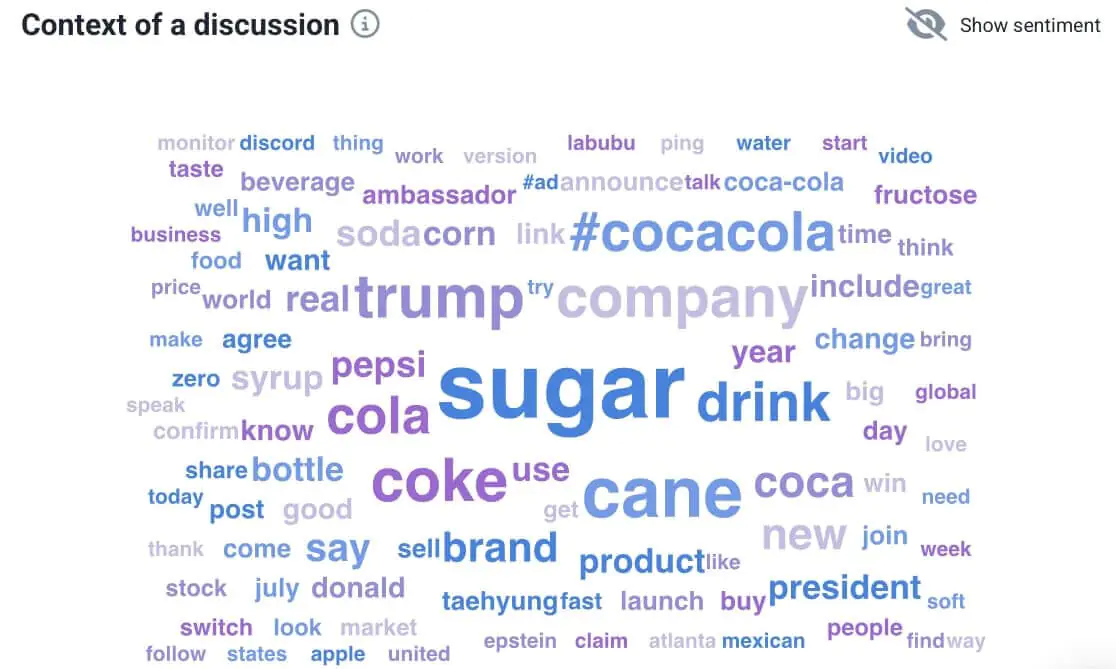
Analyze all key mentions of your brand!
What Do Brand Mentions Actually Do for SEO?
From an SEO perspective, mentions act as a digital beacon signaling your brand’s relevance and credibility:
If users talk about you, it’s good to know what, where, and how. What’s a goldmine full of keywords and insights for SEO experts to adjust their strategy.
This message will also go to Google, AI models, and all users who saw this mention.
And that creates their perspective about your brand. Especially, if some information is frequently.
This is just the tip of the iceberg. Let’s look at it in more detail:
| What Mentions Do | SEO Value They Deliver |
| Build Authority | Earn trust through association with high-authority, relevant sources |
| Create Semantic Connections | Tie your brand to key industry topics + keywords organically |
| Fuel Brand Awareness | Show up across traditional and AI search, even in voice or chat-based discovery |
| Drive Direct Traffic | Spark brand curiosity that brings users to your site, even without links |
| Enable Digital PR Strategy | Amplify coverage and discoverability through strategic placement across online platforms |
| Unlock Insights | Analyze mentions for keyword intent, tone, influencer marketing, and optimization opportunities |
1. They Build Brand Authority
When trusted sources regularly mention your brand across different platforms, it creates a brand-bat signal – a strong, public sign that your brand is active, credible, and trusted by others.
E-E-A-T framework (Experience, Expertise, Authoritativeness, Trustworthiness), which is exactly what Google looks for when deciding what to rank higher in search results.
| What external mention do | Which E-E-A-T Element They Support |
| Show people actually use and talk about your product | Experience |
| Come from niche experts or respected platforms | Expertise |
| Happen across credible sources like top blogs or media | Authoritativeness |
| Come from trusted sources, with a consistent tone and facts | Trustworthiness |
Build stronger EEAT with real-time data!
2. They Improve Brand Visibility in Traditional + AI Search
We’re not just talking about better rankings in traditional search.
That credibility also helps your brand appear across a wide range of search and AI-driven experiences, including:
- Organic search results (SERPs)
- Featured snippets
- “People Also Ask” sections
- Google AI Overviews
- Answers from ChatGPT, Claude, and other AI platforms
- Voice and visual search
It creates a ripple effect:
Stronger authority → greater reach → broader discoverability
3. They Train Search Engines (and AI) on Who You Are
Google doesn’t just learn about your brand from your homepage or LinkedIn profile. It builds a knowledge graph based on the full context of how your brand appears across the web. This includes what is said about you, who is saying it, and how frequently it occurs.
Every mention helps search engines better understand:
- What your brand does
- What topics or industries are you associated with
- What kind of language and sentiment typically surround your brand
For example, if a clothing brand is frequently mentioned alongside phrases like “quality material” or “sustainable fashion,” those associations become part of its semantic identity.
Over time, this shapes how both users and search engines perceive your brand identity.
4. They Drive Website Traffic
Let’s say someone hears your brand on a podcast. Or sees it in a blog, tweet, or news article. What happens next?
They search. They visit. They convert.
5. They Offer Actionable Insights
Monitoring brand mentions isn’t just about seeing who’s talking about you. It gives you real-time, unfiltered insight into how people perceive your brand.
You can uncover:
- What the sentiment is (positive, negative, or neutral)
- Which keywords or topics keep surfacing
- What features, products, or pain points are getting attention
These insights help you:
- Optimize your content around what your audience actually cares about
- Identify influencers or creators already advocating for your brand
- Refine your messaging for clarity, credibility, and differentiation
- See the real perception of your brand, not just your ideal version
Uncover the insights behind brand mentions!
Where Brand Mentions Appear Online
Brand mentions are everywhere people are. Here’s where they appear and how to make the most of each channel:
| Channel | Platforms | Role of Brand Mentions | Recommended Actions |
| Social Media | Instagram, X (Twitter), TikTok, Pinterest, Facebook | Boost visibility, fuel PR strategy, and generate social signals | Create engaging content, collaborate with creators, use branded hashtags, and encourage user-generated content (UGC) |
| Blogs & News Articles | Industry blogs, online magazines, and top news sites | Build SEO authority, drive website traffic | Pitch story ideas, launch PR campaigns, and collaborate with journalists and editors |
| Online Review Platforms | Google Reviews, Yelp, Trustpilot, TripAdvisor | Provide trust signals, improve local SEO, and support AI training signals | Encourage satisfied customers to leave reviews, and automate post-purchase review requests |
| Podcasts | Niche shows, branded podcasts | Build long-form trust, establish thought leadership | Appear as a guest, sponsor episodes, and repurpose podcast quotes for social media |
| Forums & Q&A Sites | Reddit, Quora, Stack Overflow | Validate community sentiment, gain niche insights | Answer questions authentically, monitor keyword clusters, and gather customer insights |
| LLMs & AI Search | ChatGPT, Claude, Gemini, Google AI Overviews | Enhance linkless visibility, boost semantic authority, and increase AI discoverability | Produce expert, contextual content; refresh authoritative sources; explore AEO (Answer Engine Optimization) and GEO (Generative Engine Optimization) opportunities |
Want to learn how to track mentions efficiently?
Dive into how to monitor social mentions or explore full-spectrum media monitoring.
Get all the mentions online!
What Is the Best Tool for Brand Mentions Monitoring?
You might be using Google Alerts to track brand mentions. And for quick, basic notifications, it’s not the worst option.
For a better understanding of where and how your brand is mentioned, you need advanced social listening.
To track mentions across social media, online publications, forums, podcasts, and even AI-generated content from tools like ChatGPT, Claude, and Gemini.
The truth is, Google Alerts misses most of that.
Here are my favorite brand monitoring tools:
- Brand24
- Chatbeat
- Semrush
- Ahrefs
These platforms give me insights into what’s being said, where it’s being said about my brand and my competitors. And what it means for my brand reputation, search visibility, and AI presence.
See who’s talking about your brand!
Key Metrics for Tracking Brand Mentions:
Volume of Mentions
The total number of brand mentions across channels. It’s a signal LLMs and search engines use to determine whether your brand deserves a spot in results.
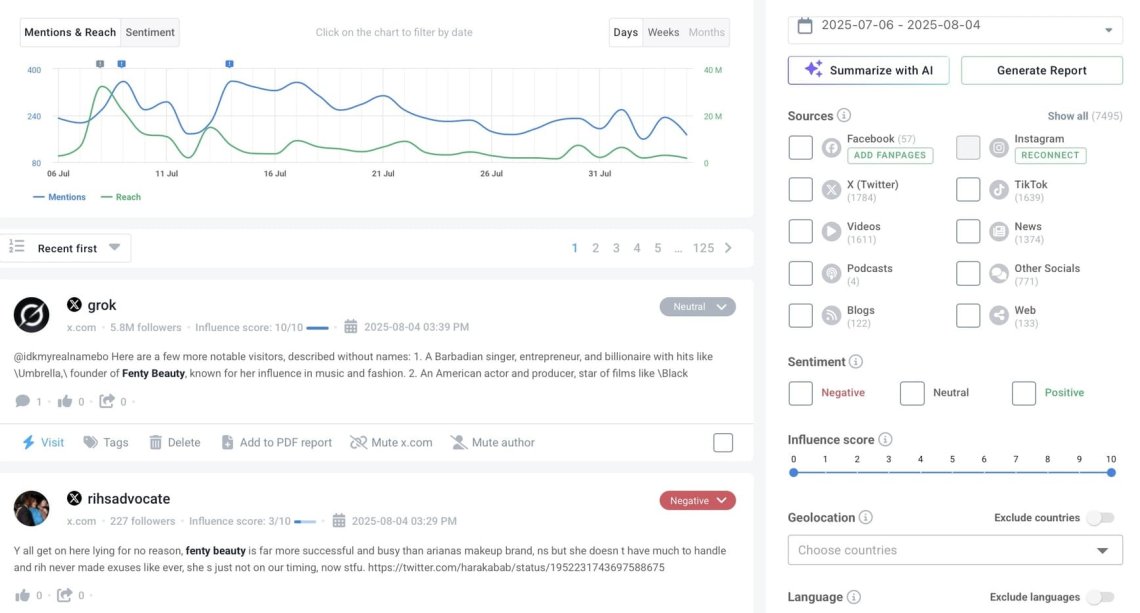
Sentiment Analysis
Are the mentions positive, negative, or neutral? Tracking brand sentiment helps you know how people feel about your brand, and when you need to change the conversation.

Turn brand buzz into real Insight!
Share of Voice
How much of the online conversation belongs to you vs. your competitors? This metric shows whether you dominate the space… or are drowned out.
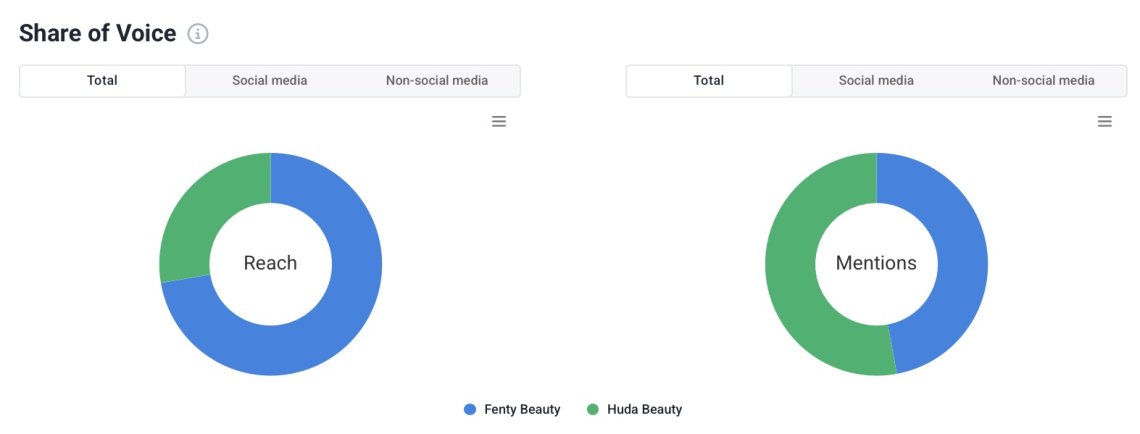
Real-time alert
Set up alerts using your brand name, hashtags, or even misspellings to stay informed the moment something happens.
Tools like Brand24 offer real-time tracking and also send weekly and monthly summaries. Giving me insights without manual digging.
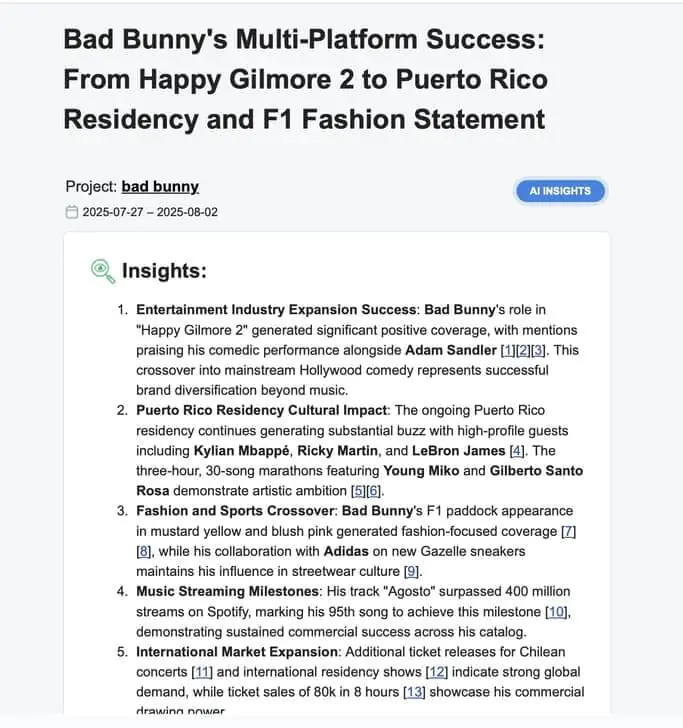
Influencer Score
Not all mentions are equal. This metric shows who’s talking about you and helps you focus on high-authority sources that move the needle.
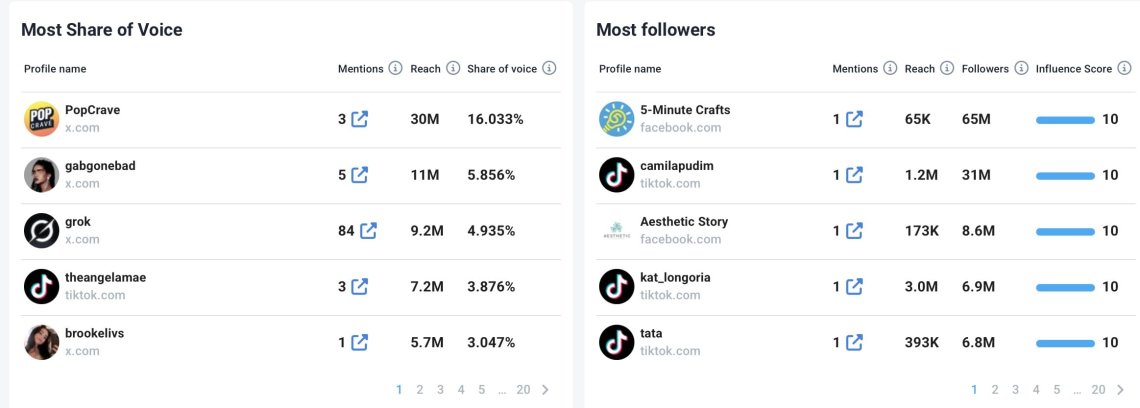
See who’s shaping your brand reputation online!
LLM Listening
Consumer behavior is evolving. People don’t just Google anymore. They ask ChatGPT, check Google’s AI Overviews, or use tools like Perplexity to explore brands, products, and services.
This shift creates a new layer of visibility you can’t afford to ignore.
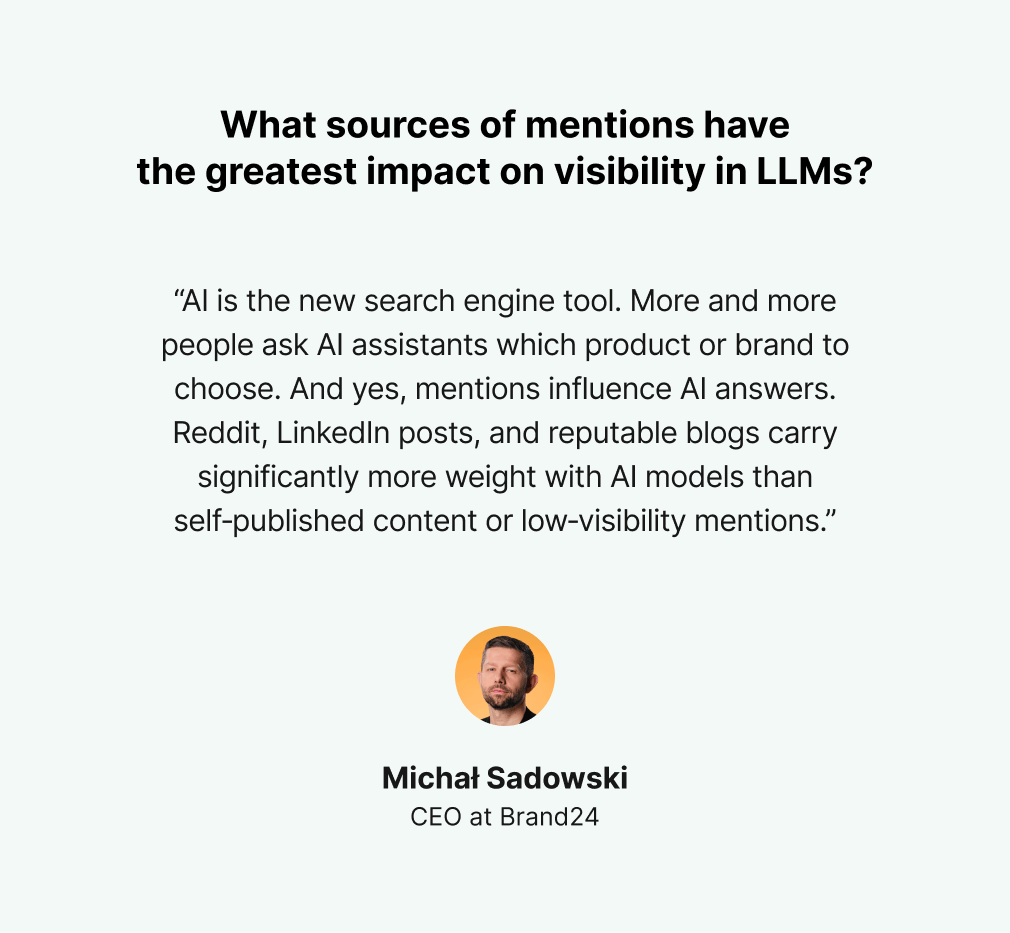
That’s where I like to use Chatbeat. It tracks how often and how positively your brand appears in AI-generated responses.
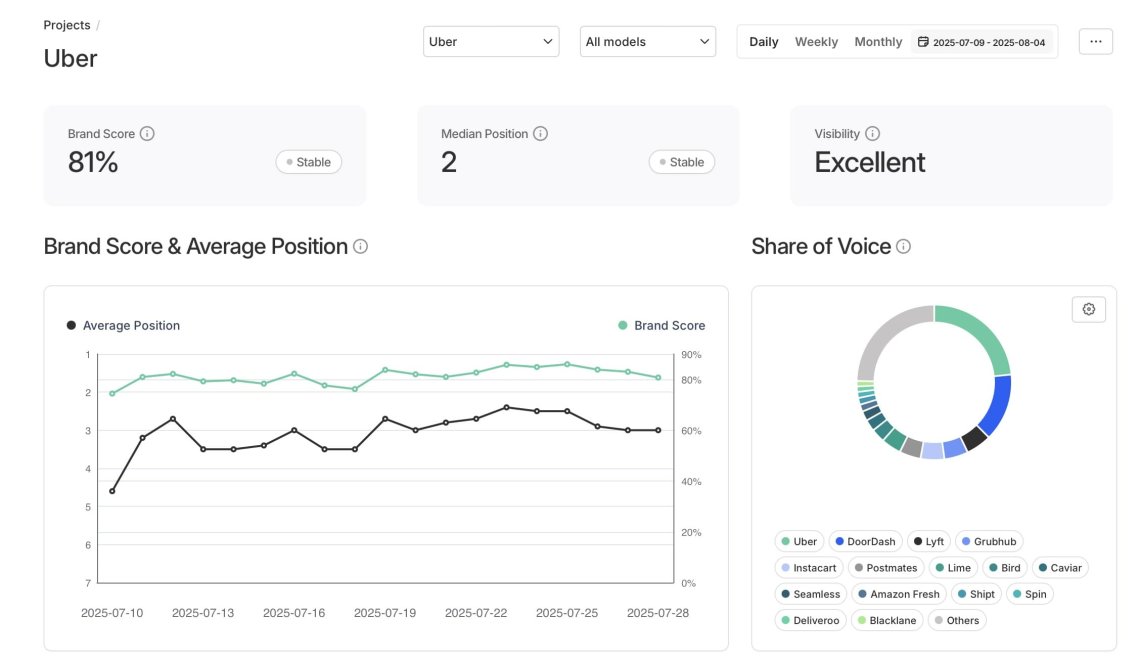
With Chatbeat, You Can:
- See how your brand (and competitors) appear in responses from ChatGPT, Claude, Gemini, Google AI Overviews, and Perplexity
- Track prompt trends: Find out what people are asking that leads to your brand being mentioned (e.g., “best project management tools” or “top fintech platforms”)
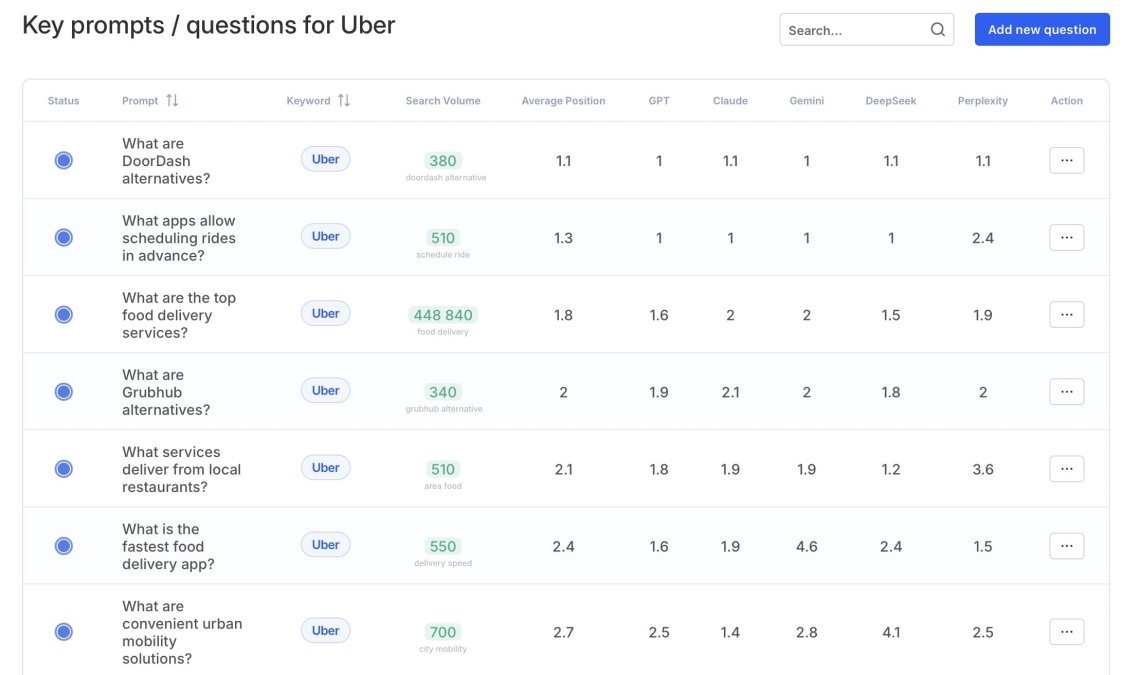
Find out which prompts lead to you and your competitors!
- Monitor sentiment and keyword associations: Are LLMs framing your brand as innovative or problematic?
- Spot blind spots: identify prompts where your competitors appear but you don’t
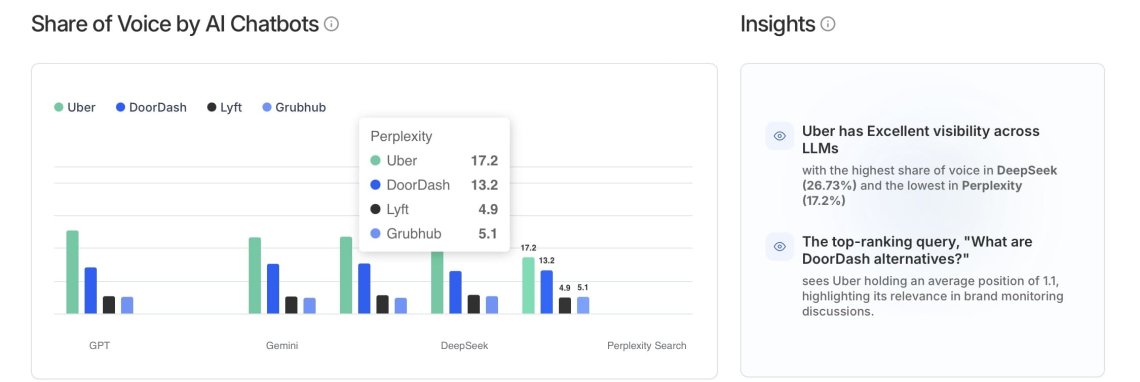
- Gain source-level insights: which blogs, websites, or pages LLMs are pulling from when referencing your brand
And this last one is a game changer for your SEO and content strategy.
If you know what sources influence AI-generated answers, you can:
- Boost and promote brand mentions already driving results
- Collaborate with influential publishers shaping AI output
- Create content optimized not just for Google, but for how AI sees and explains your brand
Used together, tools like Brand24 and Chatbeat provide a fuller picture: one captures what people are saying, the other reveals how machines process and reflect that information.
Psst, also in the Brand24 dashboard, you can find a newly launched tab with LLM Listening!
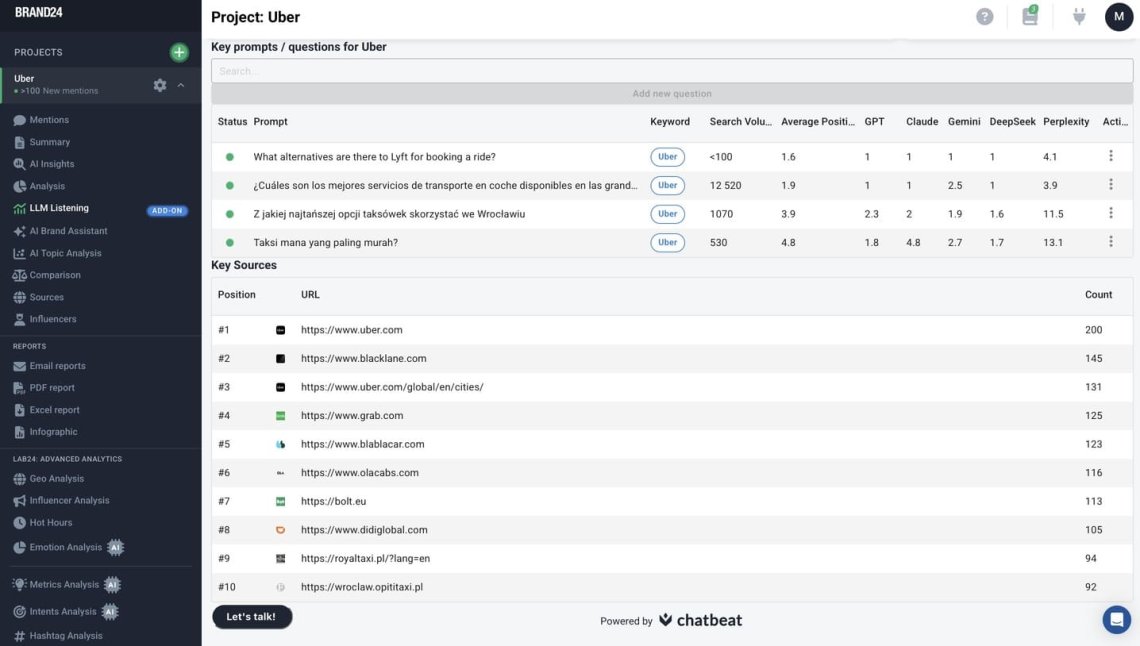
See how your brand looks in AI search results!
FAQ
1. How to build a brand mention strategy & get more brand mentions?
You don’t need a PR agency or a bunch of time-consuming extra tasks. What I feel is working is consistency.
Here’s my little guide for building real visibility (without burning me out):
- Share blog posts with other creators
Find writers, niche tech bloggers, industry creators, or anyone who already covers topics related to your brand. I like to use LinkedIn to share my content directly.
That small outreach makes it way easier for them to mention you and your brand in their next post, roundup, or news article covering the niche. That’s how you grow brand mentions across trusted sources and around your network.
- Collaborate with micro-influencers
Influencer marketing might seem expensive and complicated, like YouTube. However, a massive influencer is not needed to reach an audience.
Micro-influencers often have tight-knit communities and higher trust. A quick mention from them can spark conversations, shoutouts, or even user-generated reviews. These brand mentions feel more natural, and authenticity appears in your audience engagement and even in AI search results.
Pro tip: Tracking brand mentions also allows you to find out if people are talking about your brand, product, or offer even without a collaboration. Don’t miss those key mentions in the buzz!
- Be present in multiple sources
Social media and Google are not everything. Podcasts, interviews, and reports await you, which will be fresh air for you and your audience. It’s not just about promoting your name. It’s about building a reputation as an expert in your field.
Analyze your social media performance!
- Explore and share
Make sure your content is interesting.
Explore, analyze, reflect, and share. Repeating the same information repeatedly will not attract your audience’s attention or artificial intelligence.
Focus on what people want. Give them a reason to tag you. This snowball effect makes brand mentions appear naturally.
- Track your mentions
Set up a project using keywords, hashtags, or common brand name misspellings.
You’ll get real-time alerts, search filters, and a better understanding of how people (and AI) talk about you, using Brand24 andand24 & Chatbeat combined, I can monitor both tagged and untagged mentions online and innovative AI answers.
- Engage with your audience to boost their UGC
A simple reply, repost, or shoutout can go a long way.
When people feel seen, they share more. That’s how you keep the momentum and build brand mentions that don’t just happen once but keep coming. I like to think about it as any regular relationship: both sides need to show interest, appreciation, and vibe.
Analyze your social media performance!
Not sure how to respond to brand mentions or boost engagement?
Here’s where to start:
- How to Respond to Online Reviews? 10 Golden Rules
- What is Brand Engagement & Why is it Important?
- How to Get Customer Testimonials? Extremely Easy Method
2. How do you get brand mentions in Generative AI?
The point is to appear in the sources that LLM models trust and cite. Here’s how to do it the smart way:
- Be unique
Offer something that’s genuinely valuable, original, or newsworthy. Unique brands and ideas get talked about, shared, and cited. And that’s exactly what gets pulled into the content LLMs generate.

Here are 3 questions I always ask myself before publishing:
- What makes my content different from others?
- Is it provided „new” or/and reflect on the topic?
- Did I answer the needs of my target?
- Why would someone mention it in a blog, post, or podcast?
I’m ready to publish if there are 3 out of 4 without stress!
- Research the sources LLMs rely on in your niche
My method of checking it is to pay attention to what sources people use to answer(blogs, news sites, forums, and platforms). But it’s a manual method that can take quite a lot of time, even if it’s pretty fun!
If I want to confirm that data, I prefer to check it in Chatbeat. There, I can find a detailed list of sources across several LLMs like ChatGPT, DeepSeek, and Perplexity. This makes it much easier to compare sources around them and my competitors.
- Go beyond backlinks.
Focus on context-rich mentions that actually say something meaningful about your brand. From an SEO perspective, a single mention in a trustworthy source can outweigh dozens of low-quality backlinks.
Every mention is a signal. Start tracking now with a free trial!
- Shape your content for LLMs.
Use conversational queries, structured answers, and schema markup to boost visibility. Think of how people ask questions and write content that mirrors that; this is the core of GEO (Generative Engine Optimization).
- Keep the primary focus on building authority.
If you want LLMs to accurately reflect your brand, ensure that the message they receive is clear and consistent.
They learn from what’s out there. If your tone or story changes across sources, it can confuse both AI and people.
Start by checking how your brand is talked about with a social listening tool. Look at tone, key themes, and what’s missing. Then adjust where needed.
- Be, where people are
Posts across LinkedIn, Reddit, and Quora have a solid place in LLM answers. That’s why you shouldn’t be afraid to show up there.
I don’t think sales or ads are what people are looking for there. It’s more like a place to exchange tips. Focus on their needs and answer their real questions.
Here you will find a full guide on how to rank your brand on ChatGPT.
3. How do you turn brand mentions into backlinks?
I usually start with media monitoring tools that can find unlinked mentions, like Brand24. Then:
- Reach out, thank them, and ask if they’ll link to a relevant page
- Show the value of that link
- In return, try to offer something valuable, and you can get a bonus.
Related articles

![How Can Social Media Listening Increase Customer Advocacy? [4 Proven Ways]](https://brand24.com/blog/app/uploads/2025/03/social_media_listening_customer_advocacy_business_strategy_blog_cover_615x345-600x335.webp)


